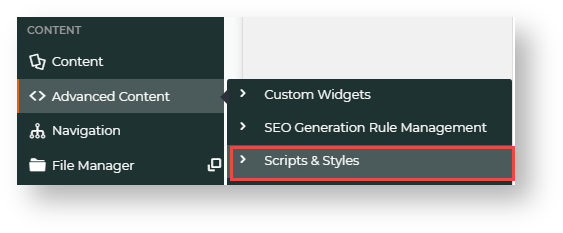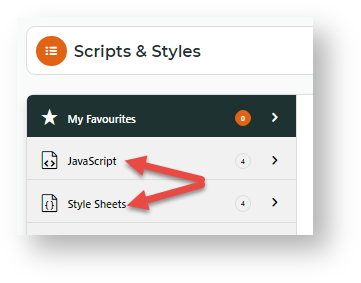Create a script or style
To best explain the functionality, we will make a simple change to the background colour of our Store Locator page.
- In your CMS, go to Advanced Content → Scripts & Styles.
- Select Style Sheets. All existing style sheets are displayed.
- Click Add Script/Style on the top right corner.
- In Add Script/Style, select Style Sheet.
- In File Name, enter an appropriate name that follows the naming conventions of our site.
- Click Add.
- In the blank editing window, start typing in your custom style sheet. (For a guide to using the Editor, see Code Editor.) Or you can paste text into the Editor.
- Click Save.
- Click Cancel to exit.
Apply a script or style to a page/template
Now we will apply that style sheet to our Store Locator page (or the Page that you have chosen).
- In your CMS, go to Content → Pages & Templates
- Use the Search tool to find 'Store Locator'. NOTE - Your page name may be different.
- Click Edit next to the page/template name.
- In the template, click Add Widget.
- In the search field, start typing 'Scripts & Styles' — the system will auto-fill the results.
- Select 'Scripts & Styles' and click Add Widget .
- The Scripts & Styles Widget automatically opens. In Description, enter a meaningful description for this use. This will display next to the style name when in use.
- Add a Layer if needed. (See: Layers.)
- In Scripts & Styles, select the style you created, then click Add.
- Click Edit to make some last minute changes to the Style Sheet, otherwise, to apply the script or style, toggle ON Enable widget on Save, then click Save.
- If the Page Preview setting is on, click Publish (top right of the screen).
- Go to your site and open the Store Locator page (or the page to which you made changes).
Compare or revert to an earlier version of a script or style
The file history of each script and style lists all versions with saved dates/times and users. You can compare versions. If you're not happy with the current version, revert to an earlier one.
- In the CMS, go to Advanced Content → Scripts & Styles.
- Click on either the Javascript or Style Sheets tab.
- Click the Edit button next to the script or style.
- In the 'Edit' page, hover on Options, then click File History.
- The current and previous versions are listed. To view a previous version, click on it.
- To compare two versions, in the Compare? column, toggle ON the two versions, then click Compare Version.
- Changes are highlighted. When you've finished viewing, click Clear Compare.
- To use a previous version, click on it, then click the Restore this version button.
- To confirm, click Save. The previous version is copied and saved as the latest version.
Delete a script or style
Deleting non-system scripts and styles in the CMS is available from 4.17+. NOTE - Scripts and styles currently used on a page or template cannot be deleted. They have to be removed from templates first.
- In the CMS, go to Advanced Content → Scripts & Styles.
- Click on the Javascript or Style Sheets tab.
- User-created files will have both 'Edit' and 'Option' buttons. To delete the file, hover over Options, then click Delete. NOTE - System files cannot be deleted.
- In the delete confirmation popup, click OK.
Check where a script or style is in use
- In the CMS, go to Advanced Content → Scripts & Styles.
- Click on the Javascript or Style Sheets tab.
- Find the file name, hover over its Options button, then click Where It's Used.
- The templates currently using the script or style are shown.
Minify Scripts and Styles
To improve the load time of web pages on your website, existing files can be minified.
- Go to Advanced Content → Scripts & Styles.
- Hover over Options, then click Minify All Files.
- In the popup, confirm you want the files minified.
Additional Information
| Minimum Version Requirements | 4.13.02 |
|---|---|
| Prerequisites | Upgrade to version 4.13.02 |
| Self Configurable | Yes |
| Business Function | Content |
| BPD Only? | Yes |
| B2B/B2C/Both | Both |
| Third Party Costs | N/A |
Related help





















